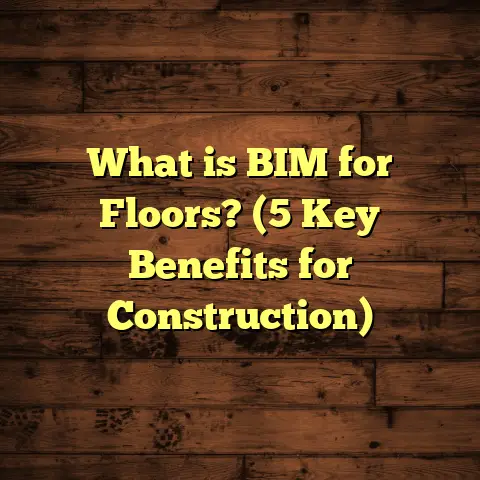What is Cupping on Wood Floors? (5 Causes & Solutions Revealed!)
I’m going to share something that might surprise you: did you know wood floors can actually warp and change shape right under your feet? I’m talking about more than just a little squeak or a scratch here and there—sometimes the wood itself starts to curve, ripple, or cup. This phenomenon is called “cupping,” and if you’ve never heard of it, it’s the kind of flooring problem that can really catch you off guard and leave you scratching your head. Over the years as a flooring contractor, I’ve seen cupping floors cause headaches for homeowners, contractors, and even designers.
I want to take you through everything I’ve learned about cupping on wood floors — what it is, why it happens, how serious it can be, and most importantly, how to fix or prevent it. Along the way, I’ll share some stories from real jobs, technical details about wood and flooring materials, plus data-backed insights that can help you avoid costly mistakes. So grab a coffee, and let’s chat about what makes wood floors cup and what you can do about it.
What Is Cupping on Wood Floors?
Let’s start with the basics: what exactly is cupping? Imagine a flat wooden floorboard. Now picture the edges of that board slowly rising higher than the center section until the plank looks like a shallow bowl or a “cup.” That’s cupping in a nutshell.
In more precise terms, cupping is a type of warping where the edges of the wood board are higher than the center across its width. If you run your hand across a cupped floorboard from edge to edge, you’ll notice a concave curve instead of a flat surface.
Why does this happen? It all comes down to moisture. Wood is a natural material made of fibers that absorb and release water vapor depending on the environment around them. When one side of a floorboard absorbs more moisture than the other, those fibers expand unevenly. Since wood expands mostly across its width rather than length, this uneven swelling causes the edges to rise above the middle.
The Science Behind Wood Movement
Wood is what scientists call “hygroscopic,” which means it absorbs moisture from the air until it reaches an equilibrium with its surroundings. The moisture content of wood (often abbreviated as MC) fluctuates with changes in relative humidity (RH) and temperature.
- When RH rises, wood takes in moisture and swells.
- When RH falls, wood releases moisture and shrinks.
For example, freshly cut (“green”) wood may have moisture content as high as 100% because it still contains water in its cells. Before being used as flooring, wood is dried in specialized kilns to reduce MC generally down to 6-9%. This drying process stabilizes wood for indoor use.
However, once installed in your home, wood will continue to respond to ambient humidity changes. This movement is normal within certain limits but can cause problems like cupping when moisture imbalances occur between the top and bottom surfaces of the board.
Manufacturing Processes Affecting Wood Stability
How your wood floor is made also influences how likely it is to cup.
- Solid hardwood flooring consists of planks milled from a single piece of wood. These planks are more prone to cupping because they expand and contract across the entire thickness of the board.
- Engineered hardwood flooring has a layered structure, typically with a hardwood veneer on top bonded to plywood or high-density fiberboard (HDF) underneath. The layers are arranged with grain directions alternating at right angles. This cross-ply construction helps resist expansion and contraction and reduces cupping risk.
That doesn’t mean engineered floors never cup—if moisture gets trapped under or above them unevenly, they can still warp. But they are generally more dimensionally stable than solid hardwood.
How Can You Tell Your Floor Has Cupped?
Spotting cupping isn’t hard once you know what to look for. The raised edges are often visible as light catching differently on the floor surface or shadows forming between boards.
If you walk barefoot or slide your hand across the floor, you’ll feel those edges sticking up like little speed bumps. Sometimes you hear creaking or popping sounds where boards rub against each other.
In severe cases, gaps form between boards as they lift at the edges but shrink in the middle. This can lead to cracked finishes or loosened nails.
5 Causes That Make Wood Floors Cup
Now that you can recognize cupping, let’s get into why it happens. Based on thousands of flooring projects I’ve handled personally and industry research, here are five major causes:
1. Moisture Seeping From Below
I can’t stress this enough—moisture coming up from underneath your floor is the number one culprit behind cupping.
Most wood floors go over subfloors made of plywood or concrete slabs. Concrete slabs especially can be a moisture source if they’re not properly sealed or protected by vapor barriers.
I once worked on a beautiful home where the floors started cupping badly just months after installation. After investigating, I found no vapor barrier had been placed over the concrete slab before installing the hardwood. The slab was absorbing water from groundwater and humidity in the soil below. That moisture wicked upward into the wood planks causing uneven swelling on their undersides.
Technical detail: Moisture vapor transmission rate (MVTR) measures how much water vapor passes through a material like concrete. Typical concrete slabs without vapor barriers have MVTRs high enough to cause significant moisture migration into flooring over time.
Data point: The National Wood Flooring Association (NWFA) recommends subfloor moisture content be below 4% before installing hardwood floors. Concrete slabs should be tested using calcium chloride tests or relative humidity probes before installation.
If you’re putting hardwood over concrete, always make sure there’s a proper vapor retarder installed between slab and subfloor or flooring.
2. High Indoor Humidity Levels
Indoor humidity can fluctuate wildly depending on location, season, and ventilation. When humidity spikes above 60%, wood starts absorbing moisture from the air.
I’ve seen cases where homeowners didn’t use air conditioning or dehumidifiers during humid months—especially in coastal or tropical climates—and their floors suffered cupping as a result.
In one renovation job I handled in Florida, the homeowner had central HVAC but turned it off during summertime vacations. When they returned, many floorboards had swollen edges from excessive indoor humidity.
Insight: Wood flooring professionals often recommend keeping indoor relative humidity between 35% and 55% year-round to minimize wood movement.
Statistic: According to studies by the Hardwood Plywood & Veneer Association (HPVA), maintaining indoor RH within this range reduces flooring defects by over 60%.
3. Water Spills or Flood Damage
Standing water or regular spills that aren’t cleaned up quickly can cause cupping fast because water penetrates into wood fibers.
One winter I dealt with an emergency call where a pipe burst inside a home’s laundry room next to hardwood floors. The water soaked into the boards within hours. By the next day, several planks were noticeably cupped and buckling.
Even if water doesn’t soak into the entire floor, localized spills near seams or edges can cause boards there to cup noticeably compared to dry areas.
4. Poor Acclimation Before Installation
This one often flies under the radar but is super important.
Acclimation means letting your wood flooring rest in the room where it will be installed for at least 3 days (sometimes longer). This gives boards time to absorb or release moisture until their MC matches the local environment.
If installers rush this step and install flooring that’s too dry or too moist for conditions, those boards will adjust after installation by swelling or shrinking unevenly—leading to cupping.
I remember working with a client who had bought cheap flooring online and insisted on quick installation without acclimation. A few weeks later, their new floor started warping noticeably.
5. Inadequate Finishing or Sealing
Wood floors need finishes that protect against moisture penetration from all sides—not just the top surface but especially edges and ends of boards.
Some cheaper finishes don’t seal edges well enough, allowing moisture into edges where it causes uneven swelling underneath.
In one project where I sanded and refinished an old floor, I noticed previous finish layers were spotty around edges due to improper application. Over time those areas absorbed moisture unevenly causing slight but persistent cupping.
How Serious Is Cupping? Should You Panic?
You might be wondering: “Is cupping just an aesthetic problem or something more serious?”
Here’s my take based on experience: cupping is more than just ugly—it signals an imbalance in moisture that can lead to bigger issues like structural damage or finish failure if left untreated.
- Raised edges cause tripping hazards.
- Cupped boards are more prone to cracking or splitting.
- Finish layers may crack or peel due to uneven surface.
- Over time, nails or staples holding boards may loosen causing squeaks or movement.
Industry data shows that homes with floors exposed to constant moisture without corrective measures have flooring failure rates up to three times higher than well-maintained installations.
So yes—catching cupping early saves money and headaches later.
Fixing Cupping Floors: What Actually Works?
If you’re staring at some cupped floors right now feeling stuck, don’t worry — solutions exist! How you fix it depends on how bad it is and what caused it in the first place.
Here’s what I usually recommend after inspecting a home:
1. Identify and Control Moisture Sources
Start by eliminating any ongoing moisture problems before trying cosmetic fixes.
- Repair leaking pipes or appliances.
- Add vapor barriers under subfloors if missing.
- Use dehumidifiers in humid climates.
- Improve crawl space ventilation.
Stopping moisture intrusion stops further swelling.
2. Balance Indoor Humidity
Maintaining balanced indoor humidity year-round helps wood stabilize naturally over time.
Using humidifiers in winter and dehumidifiers in summer keeps RH within that sweet spot — 35% to 55%.
Many modern smart thermostats now include humidity sensors for better control.
3. Sanding & Refinishing
If moisture issues are resolved but minor cupping remains due to finish swelling or raised grain, sanding floors flat followed by refinishing restores smoothness and beauty.
Professional sanding machines remove raised edges gradually without damaging boards underneath.
4. Replacing Damaged Boards
In severe cases where boards are warped beyond repair or cracked from stress, replacing individual planks is necessary.
Engineered hardwood makes this easier since you can remove and swap out single boards without disturbing an entire floor.
For solid hardwoods nailed down directly though, replacement can be trickier but still possible with care.
5. Professional Moisture Testing
Before any repair or new installation project, getting accurate moisture readings is critical.
Professionals use pin-type and non-destructive meters to measure both subfloor and wood MC precisely across multiple locations ensuring safe conditions before proceeding.
My Experience With Cupping Floors: A Case Study
One of my most memorable jobs was with a family moving into an older home built in the 1950s with gorgeous original oak floors.
They loved their floors but after rainy spring months noticed some planks starting to cup badly near windows and exterior walls.
After inspecting crawl space conditions below, we found standing water because vents were blocked by debris limiting airflow drastically increasing humidity levels below floorboards.
We installed:
- A heavy-duty polyethylene vapor barrier.
- Crawl space vents were cleared and fans added.
- Dehumidifiers placed inside crawl space.
- Floors sanded flat then finished with penetrating oil-based finish sealing edges thoroughly.
A year later their floors looked flawless again—no signs of cupping returned even after heavy rains next spring.
How Much Does It Cost To Fix Cupping Floors?
Depending on severity and cause, costs vary widely:
| Fix Type | Typical Cost Range (USD) |
|---|---|
| Moisture barrier install | $1 – $3 per sq.ft |
| Crawl space ventilation | $500 – $2,000 depending size |
| Dehumidifier rental | $50 – $150 per month |
| Floor sanding/refinishing | $3 – $5 per sq.ft |
| Board replacement | $15 – $50 per plank |
| Professional testing | $200 – $500 |
Addressing underlying moisture issues early can save thousands in repairs down the road by preventing worsening damage or full-floor replacement needs.
Interesting Data About Wood Floor Moisture Behavior
Let me share some fascinating facts based on my research:
- Wood expands roughly 0.1% across its width for every 1% rise in moisture content.
- For typical 3-inch wide hardwood plank: expansion can be up to 1/8 inch due to seasonal changes.
- Kiln drying reduces wood MC from about 30% (fresh cut) down to 6–9% stabilizing dimensions.
- Engineered hardwood experiences only about 40% of dimensional change compared to solid hardwood due to cross-layer construction.
- According to NWFA surveys, over 50% of reported flooring defects involve moisture-related problems like cupping or buckling.
Knowing these numbers helps explain why controlling moisture is so important!
Preventing Cupping: What You Can Do Now
Before I wrap up my long chat here, let me give you some practical prevention tips that I share with every client:
- Always acclimate wood flooring for at least 72 hours in installation area before laying it down.
- Use professional moisture meters to test subfloor before installation.
- Install vapor barriers under concrete slabs.
- Maintain indoor humidity between 35%-55% year-round.
- Clean spills promptly—avoid excessive water when mopping.
- Consider using engineered hardwood if you live in humid climate areas.
- Make sure all edges of boards are properly sealed during finishing stages.
Following these steps prevents most cases of cupping before they start!
Final Thoughts From Me About Cupping Floors
I hope this deep dive into cupping has given you solid insight into why floors do this weird bowing thing sometimes—and how you can deal with it confidently if it happens at your place.
Wood is an amazing material but it demands respect for its natural sensitivity to moisture changes. Treat your floors well by controlling environmental conditions and they’ll reward you with beauty for decades.
Have you experienced floor cupping? What did you try? Feel free to reach out—I love swapping stories with fellow flooring fans!





